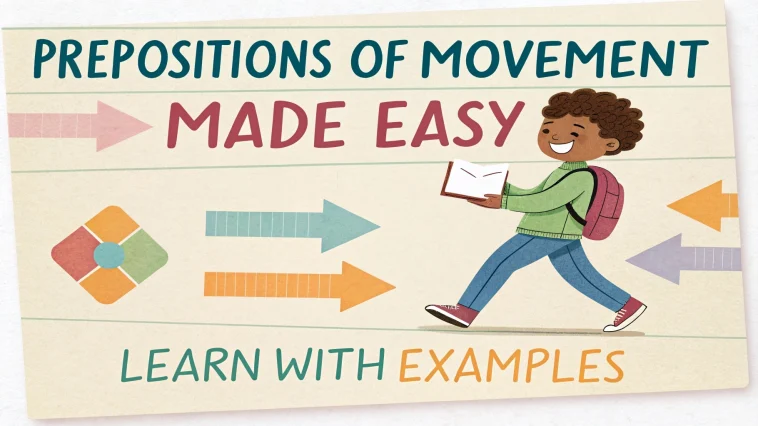Ever thought about why you say “walk through the park” but “drive to the store”? Prepositions of movement are key for clear talk. They show where we go and how we get there. This guide will show you examples to make it easy to use them right.
Key Takeaways
- Prepositions of movement indicate direction and motion.
- Clarifying movement enhances sentence construction.
- Real-life examples can make learning relatable.
- Understanding these prepositions improves communication.
- Practical applications facilitate better retention.
Introduction to Prepositions of Movement
Understanding movement is key for good English communication. Prepositions of movement show where something is going. They help us know where things move from and to.
Learning about these prepositions is important. It makes your writing and speaking better. Your stories will be more exciting and clear.
As you learn, you’ll see how prepositions are used in different ways. You’ll get examples that show their importance. This will help you understand movement in English better.
Understanding Movement Words in English
To talk about actions well, knowing movement words is key. These words are important for making sentences clear. You’ll find many verbs like run, walk, jump, and go that show how we move.
Learning these words helps you talk better. It makes it easier to say where someone is going or what they’re doing. For example, saying “She ran through the park” or “He jumped over the fence” shows movement well.
Types of Prepositions of Movement
It’s key to know the different prepositions of movement. They help us talk about actions clearly. There are two main types: direction and place prepositions. Each has its own role in describing where and how things move.
Prepositions Indicating Direction
Direction prepositions show where something is going or coming from. Words like “to,” “from,” and “towards” are common. They help us know the path or goal of movement.
For example, “She walked to the store” tells us where she went. It’s a clear way to share where someone or something is headed.
Prepositions Indicating Place
Place prepositions, on the other hand, tell us where something is during movement. “In,” “on,” and “under” are examples. They give us the setting for the action.
Like in “The cat is in the box,” it shows where the cat is. Knowing both types helps us describe actions more accurately.
Examples of Prepositions of Movement
This section shows common prepositions of movement. It also gives examples of how to use them. Knowing these helps you use them right.
Common Examples
- to
- from
- into
- out of
- over
- under
- through
Sentences to Illustrate Usage
Here are some examples of how these prepositions work:
| Movement Example | Illustrative Sentence |
|---|---|
| to | The children ran to the playground. |
| from | The cat jumped from the table. |
| into | She walked into the room excitedly. |
| out of | He stepped out of the car. |
| over | The dog jumped over the fence. |
| under | They crawled under the bridge. |
| through | She ran through the field of flowers. |
Prepositions of Movement in Everyday Contexts
Learning about prepositions is key for good talking. They help us talk about moving around, like going places or doing sports. For example, saying “I walked to the park” shows direction.
Knowing when to use these prepositions makes your talking better. Say you talk about someone running *through* a race. Or cycling *around* the block. The right preposition makes your words clearer.
Here are some examples of prepositions in daily life:
| Activity | Preposition | Example Sentence |
|---|---|---|
| Walking | to | She walked to the store. |
| Running | through | He ran through the tunnel. |
| Driving | around | They drove around the city. |
| Cycling | across | We cycled across the bridge. |
| Jumping | over | He jumped over the puddle. |
Using these words in your talk makes it clearer. It’s good for sharing stories about moving around. Try using them in your talks to make them more interesting.
Exercises on Prepositions of Movement
Doing prepositions of movement exercises helps you get better at them. You’ll try fill in the blanks and multiple-choice questions. These will make you more confident in using prepositions in everyday talk and writing.
Fill in the Blanks
Fill in the sentences with the right prepositions of movement:
- The cat jumped ___ the table.
- She walked ___ the store to buy some groceries.
- They traveled ___ the bridge yesterday.
- The dog ran ___ the park.
Multiple-Choice Questions
Choose the right answer from the options to test your knowledge:
- Where does the train go ___ the station?
- A) to
- B) from
- C) beside
- She moved ___ the road safely.
- A) along
- B) through
- C) across
- The bird flew ___ the tree.
- A) into
- B) above
- C) onto
Prepositions of Movement: Detailed Explanation
Learning about prepositions of movement is key to understanding English. A detailed explanation of prepositions shows how they are vital. They tell us where things are going or where they are.
An in-depth look at movement prepositions includes words like “to,” “from,” “into,” and “through.” Each word has its own meaning. For example, “to” means a destination, and “from” means where something starts.
Knowing how to use these prepositions makes your writing and speaking better. Using them right makes your words more clear and interesting. Start exploring to get better at English grammar and talking.
Movement Prepositions Exercises with Answers
This section has fun movement prepositions exercises with answers. They will test your English skills. You’ll find these activities exciting and challenging. Get ready to learn more!
Challenge Your Knowledge
Try these exercises to improve your movement prepositions. Fill in the blank with the right preposition. Or, change the sentence to practice.
- She walked ____ the park to get some fresh air.
- The cat jumped ____ the table when it heard the loud noise.
- They traveled ____ the mountains for a weekend getaway.
- The dog ran ____ the street to chase the squirrel.
- He drove ____ the bridge to reach the other side.
After you finish, check the answers below.
Answers
- 1. through
- 2. off
- 3. across
- 4. down
- 5. over
These exercises will help you understand movement prepositions better. They make learning fun and challenging. Enjoy the journey!
Using Prepositions of Movement in Stories
Adding prepositions of movement to your stories makes them come alive. These words help show action and direction. They make your characters and places feel real.
Imagine a character running into a room and jumping onto a balcony. This shows movement clearly. It lets readers see what’s happening.
Here are some examples of how prepositions can change a story:
- The kitten jumped up onto the table, chasing the feather that floated through the air.
- The hero dashed down the narrow alley, escaping the chaos behind him.
- The old man walked slowly along the riverbank, reflecting on his past.
These examples show how prepositions help us see the story. They make the action come alive. Good writing is about more than words. It’s about how we use them to show movement.
| Preposition | Example in Narrative |
|---|---|
| through | The soldier moved through the dense forest, navigating the shadows. |
| across | She ran across the field, her heart racing with excitement. |
| over | The airplane soared over the mountains, providing breathtaking views. |
| around | He walked around the park, enjoying the vibrant flowers and trees. |
Using movement in stories makes them more fun. It pulls readers into your world. Remember, prepositions are key to showing action and movement.
Prepositions of Movement List for Quick Reference
Learning about movement prepositions can really help you understand English better. This guide has a big list of movement prepositions. You can find examples and learn how to use them.
| Preposition | Usage Example |
|---|---|
| to | She walked to the store. |
| from | He came from the park. |
| into | They ran into the building. |
| out of | She stepped out of the room. |
| through | The cat crawled through the tunnel. |
| across | He swam across the river. |
| along | They walked along the path. |
| past | She walked past the bakery. |
| around | He ran around the field. |
| up | She climbed up the hill. |
| down | He slid down the slide. |
This list of movement prepositions is very helpful for learners. By using this guide, you can learn how to use movement prepositions in different situations.
Fun Activities to Learn Prepositions of Movement
Learning prepositions of movement can be fun. Try games and flashcard exercises to make it enjoyable. Interactive games that involve moving around make learning an adventure.
Games and Flashcards
Games can change how you learn. Try a scavenger hunt for items like “under” or “over.” This keeps you moving and helps you remember better. Flashcards are great for memorizing prepositions. Use pictures and examples to help visual learners.
| Activity | Description | Skills Developed |
|---|---|---|
| Scavenger Hunt | Find items based on prepositions like “under” and “over.” | Identification of prepositions; physical movement |
| Memory Match | Pair cards with prepositions and corresponding images. | Visual memory; recall of prepositions |
| Charades | Act out prepositions for others to guess. | Creative expression; understanding of movement concepts |
| Flashcard Race | Flashcards are displayed, and students race to say the preposition correctly. | Speed; accuracy in usage |
Tips for Mastering Prepositions of Movement
Learning prepositions of movement can really help you talk better. Using good study methods makes learning fun and useful. Here are some great tips to help you learn:
- Practice with Native Speakers: Talking with people who speak the language well helps a lot. You get to see how they use movement words in real life.
- Incorporate Movement Words into Daily Conversations: Try to use movement words in your everyday talks. Doing this helps you remember them better.
- Utilize Multimedia Resources: Watch videos or play games that teach movement words. These fun ways make learning stick in your mind.
- Make Flashcards: Make flashcards with examples of movement words. Look at them often to keep them fresh in your memory.
- Worksheet Exercises: Do written exercises that test your knowledge of movement words. This practice makes you better and more confident.
Remember these tips to improve your skills. With regular practice and creative learning, using these words will become easy for you.
Conclusion
As we finish our look at prepositions of movement, think about what you’ve learned. You now know how these words help describe motion in English. You’ve learned the different types and how to use them in everyday talk.
Keep practicing what you’ve learned. Using these prepositions in your daily talks will make your English better. It will also help you talk about movements and changes more clearly.
Remember, learning is always ongoing. Stay curious, use resources that challenge you, and ask questions when you’re unsure. These tips will help you keep getting better at using prepositions of movement.
FAQ
What are prepositions of movement?
Prepositions of movement show where something moves. They tell us where something goes. Examples are “to,” “from,” “into,” and “over.”
How can I practice prepositions of movement?
Try fill-in-the-blanks and multiple-choice questions. Play games that focus on movement. Talking in real life also helps.
Can you give me examples of sentences using prepositions of movement?
Sure! Here are some examples: “The dog jumped over the fence,” “She walked into the room,” and “He ran to the park.”
What are some common movement verbs to pair with prepositions?
Use verbs like “run,” “walk,” “jump,” “go,” and “moved.” Pair them with “into,” “through,” or “across” for better sentences.
How do prepositions of direction differ from those of place?
Direction prepositions show where something is going. Place prepositions show where something is. Examples are “to,” “from,” “towards” for direction, and “in,” “on,” “under” for place.
Why are prepositions of movement important?
They help us write and speak clearly. They make our stories and talks more interesting. Knowing them makes our words more powerful.
Are there any fun activities to learn prepositions of movement?
Yes! Play games, use flashcards, and do activities that move. Create stories with these prepositions to have fun while learning.
What tips do you have for mastering prepositions of movement?
Practice every day. Use these words in your talks. Watch videos and talk to native speakers to get better.
Read this article: Linking Words in English: A Simple Guide for Beginners.




